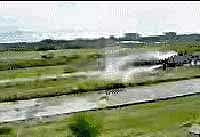




UPDATED: 2006.04.16
HONG KONG—Hundreds of people in Bomei village, in the southern Chinese province of Guangdong, are occupying land around a disputed sluice-gate that local authorities want to destroy, although the gate controls irrigation water for local farmers.
Villagers feared further violence after a woman was hit by a teargas canister Wednesday. She was initially believed by many residents to have died but later spoke to RFA from her hospital bed, saying she was seriously injured.
An estimated 1,000 armed police had been drafted to the area and were standing by a few miles (kms) from the demonstration, residents told RFA’s Cantonese service.
“It looks quite peaceful during the daytime. But more than 1,000 armed police are gradually gathering a few miles away from the village,” a local resident identified only by his surname Wang said. “Many police vehicles, too.”
“We heard the police are going to take action tonight. So we urge all the villagers to come out to the gates again. About 1,000 villagers are still there. Three to four villagers are still in detention,” he said.
We are so scared now...The government tells us nothing. They do not allow us to talk about this. We want to complain but there is no way to do so.
He said local authorities had imposed a news blackout on the area, and that a reporter from Hong Kong’s Chinese-language Oriental Daily News had been detained after trying to get into the village.
Wang said he witnessed violent clashes earlier in the week as tensions mounted. “All the injured villagers were sent to the hospital. But they are highly monitored by the police. We will fight for this until we die,” he said.
A woman resident who at the time also believed the 34-year-old woman to have died, said: “We are so scared now. We heard about the dead and injured in the clash.”
“But the government tells us nothing. They do not allow us to talk about this. We want to complain about this but there is no way to do so.”
An official on duty at the nearby Heping Hospital denied any knowledge of the incident. “We know nothing about this. If you want to interview us, you have to get credentials from the local propaganda department,” the official said.
Several people were believed injured following a dispute over plans to tear down the sluice gates in Bomei, which culminated in a violent stand-off April 12.
Police used tear gas and water cannon to disperse the crowd, witnesses said.
A duty officer at the Guangdong provincial public security office in Guangzhou declined to comment.
Bomei village is administered by Xilu township in the Chaoyang district of Shantou municipality.
Under China's existing arrangements, all land belongs to the state, but land-use rights and limited leases can be sold and exchanged on the open market. Under the Household Responsibility System brought in by Deng Xiaoping in 1980, rural authorities contract land to the collective, often a village, which in turn distributes it to individual households.
But heavily indebted local governments often fall back on the use of rural land within their jurisdiction for property developments. Rural protesters have frequently reported the use of secret meetings, bullying tactics, and mob violence by governments to enforce unpopular land transactions.
At least three people died near the neighboring city of Shanwei in clashes between local residents and armed police in December, in a separate land dispute that prompted a major government crackdown on the area.
Original reporting in Cantonese by Ka-ching Poon and Martin Wong. RFA Cantonese service director: Shiny Li. Written in English by Luisetta Mudie, and edited by Sarah Jackson-Han.